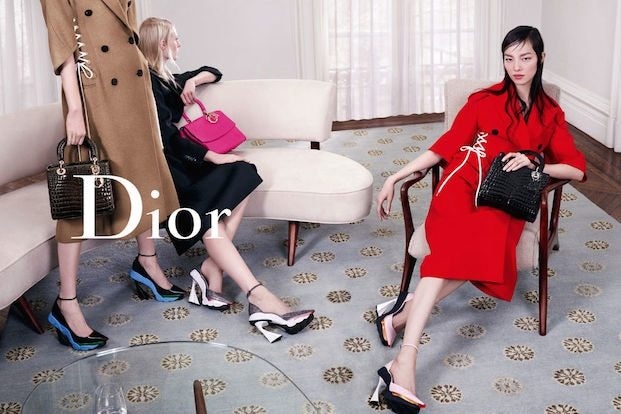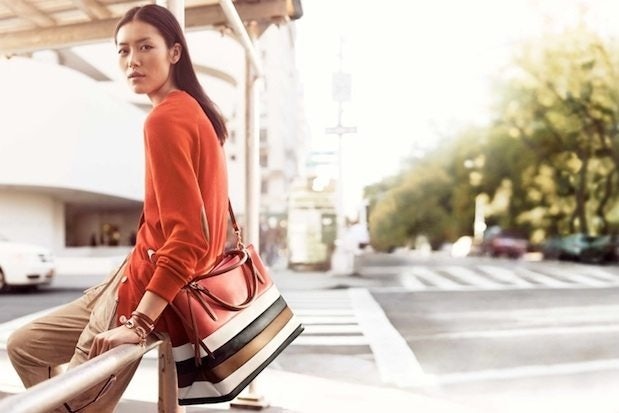
Chinese model Fei Fei Sun (R) in a 2014 Dior ad.
China’s luxury industry saw some significant changes in 2014, but the country’s rapid economic development means that it isn’t done evolving. As part of our year-end coverage, look below for a list of our top five luxury predictions for the year ahead in this dynamic market:
Chinese luxury spending will remain slow on the mainland but high across the world.#
Thanks to a confluence of ongoing factors, China’s domestic luxury market growth sunk to a dismal negative 1 percent this year. This doesn’t mean Chinese consumers have stopped spending: they’ve just taken it overseas, where they can avoid high tariffs as well as the watchful eyes of the Chinese government as its anti-corruption campaign rages on.
Spending on high-end goods is likely to remain reserved within mainland China’s borders for 2015. A string of corruption investigations and charges against officials and an ever-growing list of new anti-graft directives from the Chinese government mean that Xi Jinping’s anti-corruption campaign shows no sign of slowing. Meanwhile, the “China price” of imported luxury goods remains high as the Chinese government doesn't seem ready to lower tariffs. It even accused some luxury auto brands of cheating customers by imposing high prices and blaming tariff rates this year. Chinese officials have shown some concessions in order to keep luxury shoppers in China: they allowed the world’s largest duty-free mall to open in Hainan this year. Nonetheless, many luxury boutiques in China’s cities will function merely as showrooms for jet-setting shoppers in 2015 long as tariffs remain largely intact across the country.
The notable exception to this trend is the comparatively inexpensive masstige segment aimed at China’s growing middle class, which is buoying brands such as Michael Kors, Coach, Kate Spade, and Longchamp, as well as a developing market for discount outlet shopping and secondhand sales.

China's middle class remains interested in masstige brands like Coach.
Luxury retailers will up their e-tail game.#
China’s e-commerce market may be booming, but it’s a confusing landscape for image-conscious luxury brands. Despite the fact that China’s wealthy luxury customers are on average younger and more willing to embrace new technology, many high-end brands refuse to sacrifice their in-store experience by opening up shop online. In many cases, change comes slowly as e-commerce is seen as a high risk for brands with long legacies to protect.
Meanwhile, most of the brands that are willing to take the dive into e-tailing in China are still fearful of losing clout with their consumers. In addition to facing issues with mobile optimization, convenient payment systems, and reliable shipping with their own online shops, brands need to decide if they’re going to start selling on other e-commerce platforms when it isn't always clear which ones to choose.
The China e-commerce dominance of Alibaba is particularly vexing to luxury brands. The company’s highly successful Tmall platform is courting high-end labels, but many fear that its image is far too mass-market and discount-driven. Nonetheless, when Burberry launched its Tmall store and as a result was able to cut down on fake and “gray-market” goods, brands took notice and are now considering whether or not the tradeoffs are worth the reward. Meanwhile, luxury e-boutiques such as ShangPin and Yoox have shown more skill at conveying the upscale image that high-end brands need, but no clear winner has emerged in that market yet.
Social media is another factor making the situation even more confusing for brands. While Tencent’s WeChat has gained a significant amount of ground over Sina’s Weibo this year, Tencent’s main competitor Alibaba has invested in Weibo while Tencent has teamed up Alibaba e-commerce runner-up JD.com. As a result, only JD.com shops can sell directly through WeChat, while brands that want to promote their Tmall shops on the mobile messaging platform can only link out to them. Brands are only starting to develop their response to these complicated market trends, but 2015 will be the year that more labels develop clearer strategies to keep their brand DNA intact while embracing technology.
Consumer tastes shift from self-expression to self-fulfillment.#
While we saw logo-heavy styles fade in 2013 and an emphasis on self-expression in 2014, a growing contingent of sophisticated Chinese luxury consumers will care more about fulfilling inner desires than showing outward status in 2015. Chinese luxury consumers are more likely to spend their money on travel than on luxury goods, and demand for items with special meaning such as art and antiques is on the rise.
That being said, China’s luxury market is increasingly diverse: as the ranks of newly wealthy continue to grow, many consumers have different tastes and preferences. While experienced consumers will be taking a “been there, done that” attitude toward conventional luxury, there will always be those with new money ready to flaunt it.

Travel to top destinations such as Thailand (above) is increasingly popular with Chinese luxury consumers.
Quality trumps quantity when it comes to marketing strategies.#
When microblogging platform Weibo reigned supreme as the key social media marketing platform in China, social marketing efforts were directed almost exclusively toward viral sharing. To increase visibility on Weibo, paying top bloggers for mentions or sponsoring giveaways are tried-and-true methods for upping numbers of shares. Now that mobile messaging app WeChat is overshadowing Weibo in China, however, brands will need to focus on the quality of their message rather than the quantity of reposts in 2015 thanks to WeChat’s function as a 1:1 sharing network and limits on the number of posts an official account is allowed to make. The brands that will succeed will be the ones who get their VIP customers to share quality information with 10 of their closest friends rather than 100 random followers.
Big data hits luxury in China.#
The rise of WeChat and e-commerce in China’s luxury market means that brands will have more details on their consumers’ demands and shopping habits than ever before. Expect a growing number of brands to utilize digital tools to improve CRM, track in-store customer engagement, and pinpoint VIP customers in order to improve their Chinese clients’ experience as well as brand loyalty.